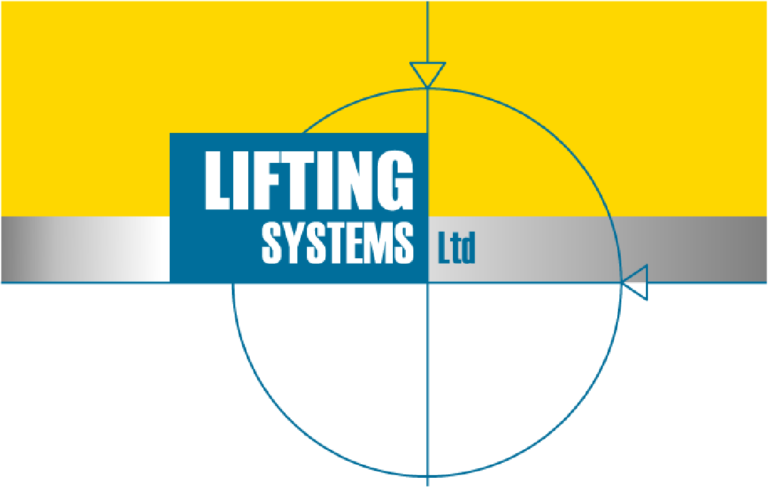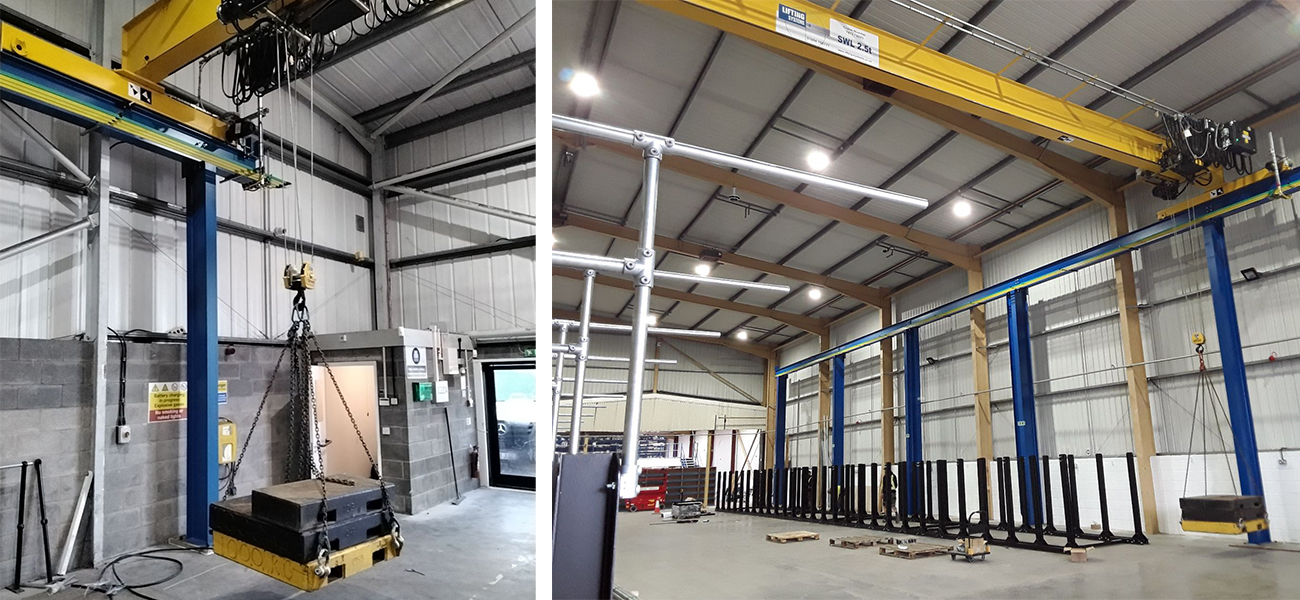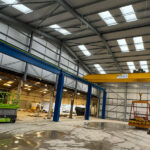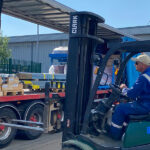Introduction to HVAC Warehouse Crane Solutions
In the dynamic world of HVAC (Heating, Ventilation, and Air Conditioning) management, the efficiency of warehouse operations is paramount. Warehouses storing and managing HVAC systems face unique challenges due to the size, weight, and complexity of these units. This is where crane solutions come into play, offering a blend of strength, precision, and safety. Modern HVAC warehouse crane solutions are not just about lifting heavy loads; they are about optimising workflow, enhancing safety, and ensuring the longevity of expensive HVAC units. This article delves into the world of HVAC warehouse crane solutions, shedding light on how they transform the traditional warehouse operations and set new standards in efficiency and safety.
The Role of Cranes in HVAC Warehousing
HVAC units vary greatly in size and weight, demanding a flexible and robust handling system. Cranes in HVAC warehouses play a crucial role in manoeuvring these units through tight spaces, lifting them for storage, or positioning them for transportation. The role of these cranes extends beyond mere lifting; they are integral to the systematic organisation of the warehouse, contributing to overall operational efficiency. Overhead cranes, for example, provide a top-down approach to handling, reducing ground-level obstructions and maximising space utilisation. This is particularly beneficial in HVAC warehousing where space can be at a premium. By streamlining the movement of goods, cranes help in reducing the time and manpower required for handling, directly impacting the warehouse’s productivity.
Types of Cranes Suitable for HVAC Warehouses
Selecting the right type of crane is critical for optimal HVAC warehouse operations. The choice depends on various factors including the size of the warehouse, the weight of the HVAC units, and the frequency of their movement. Overhead cranes are a popular choice due to their ability to move heavy loads with ease and precision. They come in various configurations, such as bridge cranes and gantry cranes, each suited to different warehouse layouts. Jib cranes, with their pivoting arm, are ideal for smaller spaces or for supplementing larger crane systems. They are particularly useful for loading and unloading HVAC units onto transport vehicles. Another option is gantry cranes, which offer mobility and versatility, especially useful in warehouses that require frequent reconfiguration.
Enhancing Safety with Crane Technology in HVAC Warehousing
Safety is a paramount concern in the operation of HVAC warehouses. The use of cranes, while enhancing efficiency, also brings a set of safety challenges that must be meticulously addressed. Modern crane technology has evolved to include a range of safety features designed to protect not only the equipment and the load but also the personnel operating these machines.
Advanced crane systems now come equipped with features like overload protection, which prevents the crane from operating if the load exceeds its capacity, thereby averting potential accidents. Anti-collision technology is another critical feature, especially in warehouses where multiple cranes operate simultaneously. This technology ensures cranes do not collide with each other, thereby preventing equipment damage and enhancing operator safety.
Moreover, remote control operations have become increasingly common, allowing operators to control the crane from a safe distance. This reduces the risk of injury in case of any mechanical failure or load slippage. Remote controls also provide a better vantage point for operators, improving their ability to navigate and place HVAC units precisely.
Additionally, regular training for crane operators is essential. Well-trained personnel are better equipped to handle the intricacies of crane operation, recognise potential hazards, and respond effectively in emergency situations. Emphasising the importance of safety protocols, such as regular checks and maintenance, also plays a vital role in ensuring a safe working environment.
In conclusion, the integration of advanced safety features and rigorous training programs are key components in ensuring the safe operation of cranes in HVAC warehouses. By prioritising safety, businesses can not only protect their workforce and equipment but also enhance overall operational efficiency.
Optimising Warehouse Layout and Crane Integration
Efficient utilisation of space is a critical aspect of HVAC warehouse management, especially when integrating crane systems. An optimised layout not only ensures smooth operation but also maximises safety and productivity. When planning the layout, several factors need to be considered.
Firstly, the type of crane system being implemented plays a significant role in determining the layout. Overhead cranes, for instance, require adequate vertical space and strong support structures. The layout should provide clear pathways for the crane’s movement, ensuring unobstructed travel along its designated path.
Secondly, the placement of HVAC units within the warehouse must be strategic. It’s essential to allow for easy access to the cranes while also considering the workflow. For example, frequently moved items should be placed in more accessible locations to reduce travel time and increase efficiency.
Thirdly, integrating cranes into an existing warehouse might require modifications to the existing infrastructure. This could include reinforcing the building structure to support additional weight or installing new electrical systems to power the cranes.
Moreover, considering future expansion or reconfiguration needs is vital. A flexible layout that can adapt to changing business needs or technological advancements ensures long-term efficiency and cost-effectiveness.
In essence, careful planning and consideration of the physical and operational aspects are crucial when integrating crane systems into an HVAC warehouse. A well-thought-out layout not only optimises the use of space and resources but also significantly enhances operational efficiency and safety.
Case Studies: Transformation in HVAC Warehouses through Crane Solutions
The real-world impact of crane solutions in HVAC warehouses can be best understood through case studies. This example illustrates the transformative effect of advanced crane systems on operational efficiency and safety.
The Client:
Smith Brothers Stores are at the forefront of innovation and growth. Recently, as part of their expansion strategy, Smith Brothers Stores identified the need for new depots in Hull and Exeter to better serve their customers across the UK.
As a longstanding customer of Lifting Systems, with a partnership, cultivated over many years of trust and a shared commitment to excellence. Smith Brothers Stores turned to us to address a crucial aspect of their warehouse setup – the efficient storage of large bundles of long pipes.
Understanding the unique requirements of Smith Brothers Stores, our team was invited to visit the new sites in Hull and Exeter. The challenge was clear – design a crane system with a free-standing gantry structure that could seamlessly integrate into the warehouse environment while efficiently handling the storage of sizable pipes.
The Hull Project:
The warehouse in Hull presented specific challenges and opportunities. With floor-to-roof heights of 7,900mm, ample space was available for Lifting Systems to meet the required hook heights for lifting products over the racking. The width of the warehouse, at 23m, demanded a thoughtful approach. The customer, mindful of the need for racking and forklift truck accessibility, required a crane system that maximised the available space.

The Exeter Project:
The challenges at the Exeter warehouse were distinct, primarily revolving around the height of the roof, standing at only 5,300mm. This posed difficulties in ensuring sufficient floor space hook coverage while meeting the crane’s height requirements. In response, Lifting Systems designed, supplied, and installed a 2.5t crane with a span of 18.5m, a travel length of 25m, and a floor-to-rail height of 4.83m.
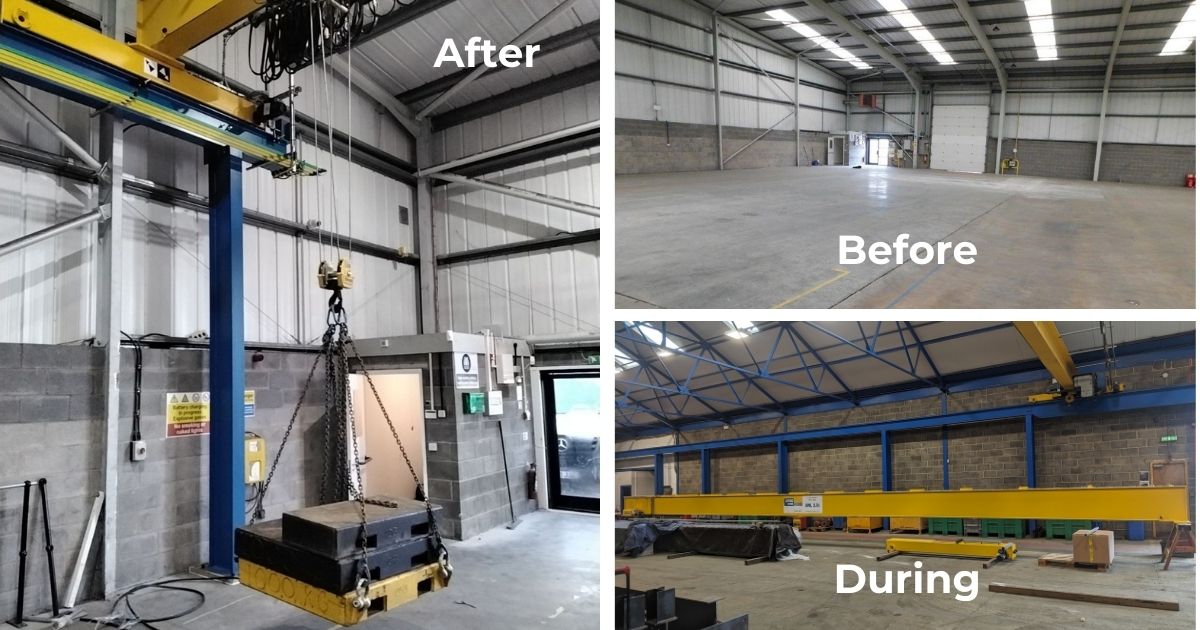
Overcoming Challenges:
One notable challenge for Lifting Systems in both projects was the need to design systems that prevented any clash between columns and floor joints. This required meticulous planning to ensure that floor bolts were positioned at least 150mm away from any floor joints, guaranteeing both safety and functionality.
As Smith Brothers Stores continues to expand its footprint across the UK, the partnership with Lifting Systems stands as a testament to the collaborative spirit driving innovation in the HVAC industry. The bespoke crane solutions provided for both the Hull and Exeter projects underscore our commitment to delivering not just equipment but tailored, efficient solutions that elevate our clients’ operations.
At Lifting Systems, we take pride in being more than just a supplier – we are partners in progress, helping businesses like Smith Brothers Stores reach new heights.
Maintenance and Servicing of HVAC Warehouse Cranes
Maintaining and servicing HVAC warehouse cranes is crucial for ensuring their longevity and safe operation. Regular maintenance checks help identify potential issues before they lead to major problems or accidents.
A comprehensive maintenance program should include routine inspections, lubrication, testing of all electrical and mechanical components, and immediate repair of any wear and tear. Adhering to the manufacturer’s guidelines for servicing and using certified technicians for repairs is paramount.
Moreover, crane operators and maintenance staff should be trained to recognise the signs of malfunction or deterioration. A proactive approach to maintenance not only prolongs the life of the crane but also ensures consistent operational safety.
It’s also important to keep a detailed maintenance log. This record-keeping aids in tracking the crane’s performance over time, scheduling regular maintenance, and complying with regulatory safety standards.
In summary, a robust maintenance and servicing regimen is a non-negotiable aspect of operating HVAC warehouse cranes, playing a critical role in safeguarding equipment, personnel, and the overall workflow.
Custom Crane Solutions for Diverse HVAC Warehouse Needs
In the world of HVAC warehouse management, one size does not fit all. The diversity of warehouse sizes, layouts, and the specific needs of different HVAC components call for custom crane solutions.
Bespoke crane designs can significantly enhance operational efficiency in HVAC warehouses. For instance, a warehouse handling a wide range of HVAC unit sizes might benefit from a combination of jib and overhead cranes, each configured for optimal performance in different areas of the warehouse. Customisation can also involve adapting cranes to work within the spatial constraints of a warehouse, ensuring that even in compact spaces, material handling remains efficient and safe.
Moreover, the integration of crane accessories tailored to specific tasks can further streamline operations. Attachments such as specialised lifting beams, spreader bars, or custom hooks designed for unique HVAC components can facilitate safer and more efficient handling, reducing the risk of damage during lifting and transport.
The process of designing a customised crane solution begins with a thorough assessment of the warehouse’s operational needs, including an evaluation of the types of HVAC units handled, frequency of movement, and any specific challenges posed by the warehouse layout. Collaboration with crane manufacturers and engineers is crucial in this phase, as their expertise can guide the selection of the right crane type, capacity, and custom features.
Custom crane solutions offer a way to address the specific needs of HVAC warehouses. By tailoring crane systems to the unique requirements of each facility, businesses can achieve a higher level of operational efficiency, safety, and adaptability.
Conclusion: The Way Forward for HVAC Warehouse Efficiency
In conclusion, the integration of advanced crane solutions in HVAC warehouses represents a significant step forward in operational efficiency and safety. From the strategic selection of the right type of crane to the implementation of cutting-edge technologies, these solutions are transforming the landscape of warehouse operations.
The case studies highlight the real-world benefits, while the emphasis on regular maintenance underscores the importance of sustaining these benefits over the long term.
As we look to the future, it’s clear that technological advancements will continue to play a pivotal role in shaping the efficiency of HVAC warehouses. By staying ahead of these trends and investing in the right solutions, businesses in the HVAC industry can look forward to reaping substantial rewards in terms of productivity, safety, and overall operational excellence.
